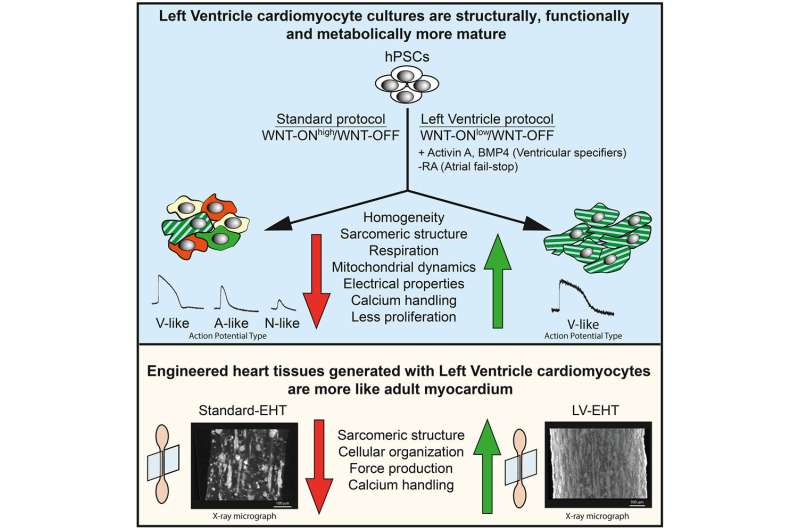This article has been reviewed according to Science X's editorial process and policies. Editors have highlighted the following attributes while ensuring the content's credibility:
fact-checked
peer-reviewed publication
trusted source
proofread
A heartbeat in a dish: Growing specialized heart cells

Detailed examinations of the heart have revealed the pivotal role of the left ventricle—it's the area of the heart that develops first and provides the force to pump blood around our bodies. Crucially, it is also the area most commonly implicated in heart disease and heart attacks and it is the area most prone to suffering the cardiotoxic effects of certain drugs.
Researchers at the Crick have now developed a way to grow specialized left ventricular heart muscle cells from stem cells, opening up new opportunities for research into heart disease, drug screening, and potentially the development of new treatments.
Their methods are published today in Cell Reports Methods and have also been licensed to Axol Bioscience to commercialize the protocol for the generation and sale of cardiomyocytes for R&D and the provision of contract research services, especially in field of drug screening and cardiotoxicity assays.
Growing a heartbeat
The work has been driven by Andreia Bernardo, a Wellcome Trust Career Re-Entry Fellow at the Crick who has recently started her own lab at Imperial College London. Growing left ventricular cardiomyocytes (heart muscle cells) is a complicated process, and one that is based on a detailed understanding of developmental biology, as Andreia explains.
"In order to encourage cells to specialize, you have to understand the natural developmental process. We set out to understand the different chambers of the heart—how are they formed, and what are the genes and pathways involved in their development.
"It's only with this detailed understanding of early embryonic changes, that we could apply the knowledge in stem cell models, starting with forming the correct mesoderm lineage, the first phase in cell specialization. We also found that blocking the retinoic acid pathway acts like a fail stop, preventing different types of cardiomyocyte from forming.
"What we end up with is a near homogeneous population of left ventricular cardiomyocytes that beat in synchrony. It's like a Mexican wave across the dish. We can study these cells functionally in 2D cultures and we can even make engineered heart tissues with them and measure their force and study them in this 3D environment. Surprisingly, we show that left ventricle cardiomyocytes or the engineered heart tissues generated from them are stronger and have improved structural, functional and metabolic maturity compared to the standard cardiomyocyte models."
A method 30 years in the making
Andreia's work has roots in research carried out more than 30 years ago. Jim Smith, Emeritus Scientist at the Crick, first examined molecules that drive embryonic development in the early amphibian embryo using the frog Xenopus laevis as a model.
Andreia and Jim met when they were both working at Cambridge University, and they began collaborating on research in mouse embryos, progressing the work towards human stem cells, a partnership that would continue when Jim became Director of the MRC National Institute for Medical Research, one of the Crick's founder institutes.
"When I was an early career researcher I had no idea how my findings might one day be applied," says Jim. "It's very exciting seeing the molecules we first observed in frogs now being a part of this process.
"This really highlights the value of discovery research—you never know where it might lead."
It was the partnership between Andreia and Jim that pushed the research forward through challenges over the years.
"I took a long period away from work to care for my child who was very unwell and if it wasn't for Jim's support, I don't know if I would have come back," says Andreia.
"And more recently, just as we were refining our methods, we were forced to stop our research because of the pandemic. So many cultures were lost and that set us back nearly a year."
But thankfully, their team returned to the Crick and with support from the Crick translation team, found a partner in Axol Bioscience.
Ranmali Nawaratne, Senior Business Manager in the Crick translation team, said, "When Andreia and Jim brought this protocol to our team, the potential was clear. We were able to file a patent and also provide in-house translation funding that they could use to generate more data on the nature of these cardiomyocytes.
"It's been brilliant working to translate this lab discovery into a marketable method. It is exciting to see how these specialized cardiomyocytes will be applied in future research and potentially in cell therapy, in time to come."
Future applications
The new agreement with Axol Bioscience will allow more labs across the world to use these specialized heart cells in their own research. This could be testing the safety of different drugs or developing new drugs for the treatment of left ventricle specific diseases.
Andreia has also recently started her own research group at Imperial College where her team will use the cells to study left ventricular development, maturation and disease. Diseases like hypertrophic cardiomyopathy, a congenital heart condition affecting specifically the left ventricle, will be better modeled using this method. Her team will also be exploring if these cells have therapeutic value for treatment of heart failure.
More information: Nicola Dark et al, Generation of left ventricle-like cardiomyocytes with improved structural, functional, and metabolic maturity from human pluripotent stem cells, Cell Reports Methods (2023). DOI: 10.1016/j.crmeth.2023.100456
Journal information: Cell Reports Methods
Provided by The Francis Crick Institute





















